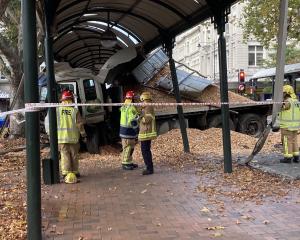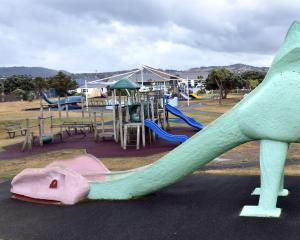December 2011: Initial seismic assessment, performed by Opus, delivered to Ministry of Justice. Declares the tower and areas in its drop zone to be ''high risk'' and earthquake prone.
Estimates of required work include tower strengthening of about $750,000 and complete complex strengthening of about $4 million.
Ministry immediately vacates danger areas of Stuart St courthouse, including tower area and two courtrooms.
Ministry ''went to market'' to find urgent temporary accommodation, settling on John Wickliffe House. February 2012:
Jury trials temporarily moved to Invercargill.
March 12, 2012: Opus Architecture produces ''Dunedin Law Courts Tower Strengthening Design Options Report''. Estimates cost of tower and external ornamentation strengthening at $2.5million. Suggests a 20-week construction window and no need for vacating the complex.
May 18, 2012: Ministry holds a ''workshop'' with its own property staff, engineering consultant companies, and Heritage NZ, on what to do with the courthouse. Workshop recommends bringing whole Stuart St complex up to 70% of the new building standard (NBS). Decides it is not possible to retain services at Stuart St while such a large amount of work is undertaken.
May 2012: Family and civil registries moved to John Wickliffe House.
July 2012: May workshop's proposals put to ''ministry's senior leaders'', who approve the approach. At this point it is decided to ''close the building completely'' due to the extent of work required.
July 2012: Ministry decides to ''develop options to relocate facilities out of Stuart St''. Ministry went to market and considered ''a number of commercial properties'', including:
Carisbrook Stadium.
Former Chief Post Office.
Further space in John Wickliffe House.
The Payless Plastics building.
September 24, 2012: Ministry's approval for lease of 184 High St given.
October 24, 2012: Lease for 184 High St begins.
November 13, 2012: 184 High St assessed as 75% NBS.
May 1, 2013: Lease for 184 High St formally signed.
May 2013: Ministry announces it is in the final stages of getting approval for strengthening work for historic courthouse - set to go out for tender later that year. Construction expected to take two years, ministry says.
July 17, 2013: ''Producer statement'' for 184 High St signed off, confirming strengthening work has lifted the building to 100% NBS.
August 2013: A range of court services moved to 184 High St.
April 2014: Stephenson and Turner appointed as lead designers for historic courthouse work.
''Later'' in 2014: Tonkin and Taylor undertake geotechnical investigations, finding a ''risk of liquefaction under the foundations of the tower''.
May 18, 2015: Ministry moves remaining Stuart St services to High St, effectively mothballing the historic courthouse (although some services remain in the CIB Building).
June 20, 2015: New Zealand Criminal Bar Association calls for partial reopening of safe areas of historic courthouse in lieu of clear information on its future.
July 11, 2015: Otago University law alumni plead with Government for court to be saved.
July 14, 2015: Dunedin barrister Anne Stevens fronts the Dunedin City Council, suggesting the decision to save or abandon the courthouse will be a government-level financial one, and calling for council support in lobbying the Government to retain court services at the historic complex. DCC agrees.
August 18, 2015: Dunedin Mayor Dave Cull writes to Ministers of Tourism (John Key), Finance (Bill English), Police (Michael Woodhouse), Courts and Justice (Amy Adams), and Culture and Heritage (Maggie Barry), asking for dialogue and laying out the council's concerns.
August 28, 2015: Dunedin Courthouse Taskforce assembled to fight on the historic building's behalf.
End of August, 2015: Business case detailing the work needed, and its associated cost, to return services to the historic court complex and its cost to be delivered to Justice Minister Amy Adams.
No date known: Amy Adams to take that business case to the Cabinet, where the courthouse's fate will be decided.
March 1, 2017: Lease expires on 184 High St, although ministry has right of renewal for two further terms of three years each.












